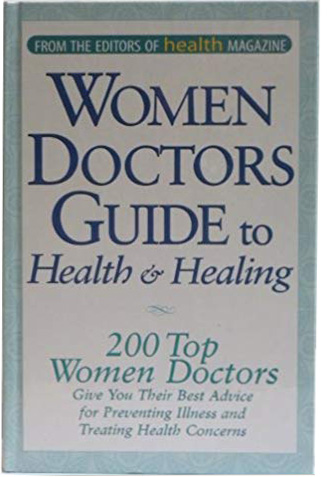Women Doctors Guide To Health and Healing

From the Introduction/Page 4
Women Doctors Guide to Health & Healing had been in production for nearly a year when an interesting study published in the Journal of the American Medical Association hit the news. “Female Physicians Spend More Time with Patients,” read the headlines. The article, an analysis of more than 26 studies conducted over the past 34 years, found that female doctors engage in more positive social and emotionally focused talk than their male counterparts.
This news came as no surprise to the writers and editors working on the book. After interviewing hundreds of top female medical professionals about everything from atherosclerosis to yeast infections, we know that female doctors have a unique perspective on all aspects of a woman’s health.
Page 415 -417
Physical intimacy plays a powerful role in creating an emotional bond between partners in a relationship. “The inability to fully enjoy sex can make you feel inadequate, anxious, and depressed,” says Dr. Bartlik. Barbara Bartlik, M.D. is a sex therapist and psychiatrist at New York-Presbyterian Hospital’s Weill Cornell Medical Center in New York City. Having sex seldom or not at all can also adversely affect your physical health, says Winnifred B. Cutler, Ph.D., a reproductive biologist and founder of the Athena Institute, a biomedical research center in Chester Springs, Pennsylvania.
One of her studies revealed that young women who had sex sporadically – such as a hot weekend followed by 10 days of celibacy – had reduced estrogen levels similar to those of older women, thus putting them at risk for osteoporosis and other health problems. However, decreased sexual activity may be a sign of low estrogen levels, rather than the cause.
Frequent sex is good for your health. A woman’s body is designed for steady loving, not for feast or famine. – Winnifred B. Cutler, Ph.D.
On the other hand, regular weekly sex is known to be associated with a regular menstrual cycle, normal estrogen levels and bone density, and a milder, later menopause. “Our bodies appear to be designed for steady loving, not feast or famine,” says Dr. Cutler.
The need for regular loving is why our bodies excrete chemical substances, called pheromones, to attract the opposite sex. Dr. Cutler, who is the co-discoverer of pheromones in humans, says her research suggests that simply having a man – and his pheromones – around can be a plus for a woman’s health. In one study, Dr. Cutler swabbed male pheromones onto the upper lips of women who had abnormal or irregular menstrual cycles. After 14 weeks of treatment, the women’s periods became more regular – in fact, within three days of the optimal 29.5-day cycle. “Men’s pheromones somehow affect our hormones, especially estrogen,” she concludes.
Sex is such an integral part of our lives that the average woman with a healthy libido reportedly has about six sexual thoughts or feelings a day. The average male has more (of course): as many as 11 a day. If these numbers seem high to you, keep in mind that the totals include everything from a daydream to a fleeting tingle triggered by an attractive passerby. If you worry that you’d score below average, relax. Dr. Bartlik points out that we’re not always aware of these thoughts or feelings.
Libido is just part of the story. In her book, Love Cycles: The Science of Intimacy, Dr. Cutler explains that sexual desire has three components: libido, arousal, and willingness. Libido is that elusive connection between body and brain that leads us to actively seek sex. Willingness and arousal are the more tangible psychological and physical pieces of the puzzle. To figure out where your lack of desire originates, you have to examine all three components.
PUMP UP YOUR PHEROMONES
Having a hard time getting the object of your desire to notice you? You may benefit from extra pheromones. Pheromones are subtle aromas that humans secrete to attract and communicate sexually with the opposite sex.
“They lure someone to you more powerfully than – or at least as powerfully as – appearance,” says biologist Winnifred B. Cutler, Ph.D., who co-discovered pheromones in humans.
Research shows that pheromone production diminishes with age, especially after menopause or a hysterectomy. So Dr. Cutler created a product called Athena Pheromone, an unscented fragrance additive that is a chemical copy of naturally occurring substances. There are separate formulas for women and men.
A few small studies tested the product and concluded that it actually works. J. Clark Bundren, M.D., a gynecologist and reproductive endocrinologist at the University of Oklahoma at Tulsa, studied women who had undergone hysterectomies and had then noticed a drop in their partners’ sexual interest in them. Dr. Bundren found that with regular applications of the pheromone substitute, these women reported increased attention from their once-ambivalent mates... if you’re interested, you can order the fragrance {additive} online at www.athenainstitute.com.
END OF EXCERPT
COMMENT FROM ATHENA INSTITUTE: Both Athena Pheromone 10:13tm for women and Athena Pheromone 10Xtm for men are cosmetics that can increase your attractiveness to the opposite sex. Neither product is an “aphrodisiac.”